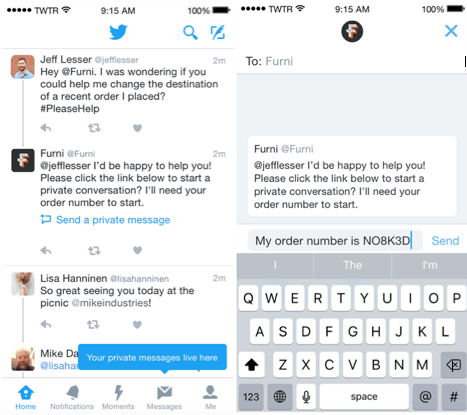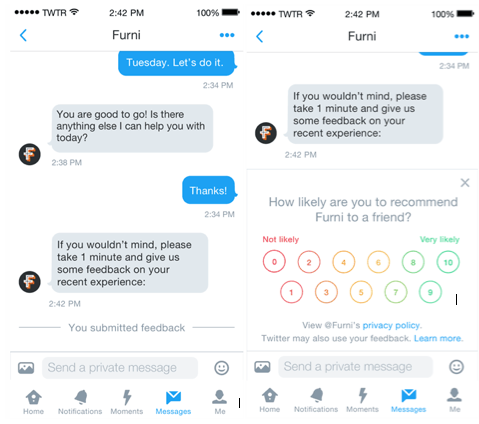An increasing number of consumers are using social media to connect with brands and more than a third of people now use social media to escalate a complaint. Dealing with a complaint properly can drive brand loyalty, and as a result complaint handling is becoming an increasingly important part of brand marketing.
A recent study conducted recently by Eptica found that Twitter and Facebook are both more accurate and faster at delivering customer service responses than email. The average email response time was found to be 1 day and 10 hours, while the average response on Facebook came in just under 9 minutes, with Twitter coming in at only 4 minutes. These findings prove that social media has cemented its position as the most efficient channel for customer service.
To help brands engage with customer feedback more smoothly, Twitter has recently added two new customer service tools. These tools make it easier for brands to collect customer feedback, adding value for businesses and their customers.
Direct Message prompt
The first tool gives brands a simple way to start a direct message conversation with a customer by letting them embed a direct message link in a tweet. This helps speed up the feedback process and provides a seamless transition into a one-to-one conversation with the brand. By moving the conversation into a DM, you can keep any negative feedback out of the public newsfeed and into a secure environment where users can share their personal information, such as contact details, with the you.

Customer Feedback
The second tool, ‘Customer Feedback’, lets businesses send users private surveys to rate their opinion of the brand after a customer service interaction. The tool provides brands with a structured way to measure and improve their service experience. Learn more about Twitter’s new customer service tools here.

How to respond to negative (and positive!) comments
It’s important to respond to all comments and questions, whether they’re positive or negative, and ensure that responses are consistent across all channels. If you receive a negative comment, apologise that the user has had a negative experience, then try to move the interaction to direct message as quickly as possible so you can get to grips with their complaint without the constraints of 140 characters and out of the public eye. Potential customers browsing your feeds will be reassured by your responsiveness and ability to publicly resolve an issue than they would be if you brushed it under the rug.
Shout any positive feedback from the rooftops! Thank the customer for their feedback then retweet, repost and share this to fill people’s feed with positive reviews of your brand. Earlier this year, Twitter launched a new feature allowing brands to embed their customer’s happy social testimonials into their Twitter ads. By creating a ‘brand enthusiast gallery’, brands can use customer reviews and comments as content for their marketing campaigns.